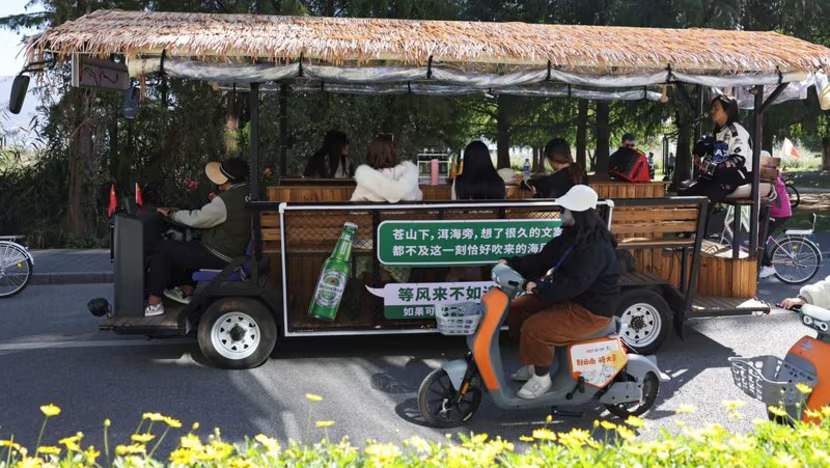China’s visa-free moves a hit with Southeast Asian tourists; geopolitical gains also on itinerary: Analysts

(Photo credit: Adobe Stock)
Source: CNA
Visiting snow-capped mountains, scenic lakes and deep gorges is all in a day’s work for He Quan.
The 35-year-old private driver based in the city of Lijiang in Yunnan plies his trade eight hours a day, ferrying passengers around the Chinese province’s key attractions. He did not want to disclose his earnings but CNA understands each trip ranges from 150 yuan to 1,000 yuan (US$21 to US$140).
Known as “Ah Quan Shifu” to them, his sole clients were domestic travellers just six months back. But a different clientele has emerged - now, four to five times a month, his services are engaged by Chinese-speaking tourists from Southeast Asia, specifically Singapore and Malaysia.

(Photo credit: He Quan)
Although the new clientele still makes up less than 10 per cent of his overall business, Mr He welcomes the additional income.
“As tourism sector workers, we don’t just focus on domestic tourists; we also need to interact with foreign guests,” he said. “This helps expand our customer base.”
Mr He added that his Singapore and Malaysia passengers often share their experiences on social media platforms like Xiaohongshu, boosting publicity and attracting more business.

A man sings for customers touring the Erhai lake on a sightseeing bus, in Dali, Yunnan province, China November 10, 2023. (Photo: REUTERS/Florence Lo)
China has recorded a surge in foreign arrivals since dismantling nearly three years of strict COVID-19 controls early last year. The resumption and expansion of visa-free policies have been key as they have streamlined the travel process, according to analysts.
Travellers from the region - namely Singapore, Malaysia and Thailand - are driving demand under the visa-free umbrella, which experts say ties in with their relatively closer geographic and cultural links to China.
While the economic benefits of greater inbound tourism are clear for the world’s second-largest economy amid sluggish post-pandemic recovery, analysts point out that there is also a geopolitical dimension amid rising tensions with the West.
“Inbound tourism can be regarded as China’s new soft-power diplomacy … (it) serves a role here from a geopolitical perspective,” Professor Sam Huang, a scholar internationally noted for his research on China tourism, told CNA.
“The pandemic has alienated China to a certain degree. Now China needs to let more foreign citizens experience its development in person.”
POST-PANDEMIC SURGE IN REGIONAL TOURISTS
China has had mixed fortunes in tourism since reopening its borders in January 2023.
Outbound tourism has recovered well, with Chinese tourists reclaiming their crown as the world’s biggest tourism spenders. Chinese spending on travel abroad hit US$196.5 billion in 2023, beating the United States (US$150 billion) and Germany (US$112 billion), according to the World Tourism Organisation.
Meanwhile, inbound tourism has struggled to recover. China welcomed 35.5 million foreign visitors last year, less than 40 per cent of the 97.7 million arrivals it logged in 2019 before the pandemic.
To boost this, China has since unilaterally established visa-free arrangements with about a dozen countries, mostly in Europe, to streamline the travel process. Mutual visa waiver agreements have also been established with three Southeast Asian nations: Malaysia, Singapore and Thailand.
The strategy has seen results. Nearly two million foreigners entered China visa-free in the first quarter of the year, up by more than two and a half times compared to the same period on-year, according to data from the National Immigration Administration. Tourism accounted for over 30 per cent of these visits.
The three Southeast Asian states were the largest source countries for visitors to mainland China in the first five months of the year, according to international online travel agency Trip.com. Germany and France rounded off the top five list.
“In the same period, the number of travel bookings from Thailand skyrocketed by more than 14 times compared to the same period last year. Visitors from Malaysia and Singapore also grew rapidly, by almost 10 times and some 5.7 times respectively,” Mr Edmund Ong, general manager of Trip.com Singapore, told CNA.
Professor Huang, the China tourism specialist, attributes this to the geographic and cultural proximity between Southeast Asian countries and China.
“Visa-free policies can have a stronger effect on people in these countries than those in distant European countries”, said the research professor in tourism and services marketing at Australia’s Edith Cowan University.
He added that people may also have tightened their travel budgets after the pandemic. “Short-haul international travel means lower costs and can be more affordable.”
YUNNAN A HOT DESTINATION
With its picturesque scenery and relatively closer proximity as opposed to the rest of China, Yunnan has emerged as a top travel pick for Southeast Asian tourists.
Tan Ziteng, a 27-year-old accountant from Malaysia, is one such visitor. She travelled to Yunnan last month with her husband for their wedding photoshoot.
They spent a day in Lijiang as part of a RM6,000 (US$1,270) package that included four photoshoots, each in a different costume. Subsequently, they explored Dali and Shangri-La at their leisure, savouring the region's scenic beauty and cultural richness.
“I've watched plenty of promotional videos showing how beautiful it is. We can also explore nearby cities while we're there,” said Ms Tan.

A Malaysian couple's wedding photo in front of Yulong Snow Mountain in Lijiang, Yunnan Province, China. (Photo: Tan Ziteng)
Hotels in Yunnan said they have experienced an increase in foreign tourists since December last year. Jinghua Shuiyuan Inn in Dali has logged a 20 per cent increase in occupancy since December last year, with a notable influx of guests from Southeast Asia as well as Macao, Hong Kong and Taiwan.
Chan Brothers Travel, a Singapore travel agency, told CNA that Yunnan is a popular destination within China for Singaporean travellers, along with other places like Zhangjiajie and Jiuzhai Valley. The company observed an over two-times increase in trips to China for the first six months of the year, compared to the same period in 2019.
There has also been a shift towards longer 9- to 14-day itineraries compared to shorter tours before the pandemic, noted Mr Jeremiah Wong, a senior marketing communications manager at Chan Brothers Travel. He added that the agency has introduced extended travel packages to accommodate this.
Another Singapore travel agency, EU Holidays, says China has surpassed Europe to become the top tourism destination. Its director Wong Yew Hoong attributed this to China being among the last countries to reopen borders, leading travellers who have already visited other destinations to consider the country next.
He also highlighted the value for money and China's enhanced infrastructure as other key factors driving this shift.
China resumed its 15-day visa-free policy for Singapore citizens in July 2023. This allowance was extended to 30 days from February this year and made mutual.
Overall for foreign tourists, Trip.com statistics show that major cities like Beijing, Shanghai, Guangzhou, and Shenzhen, known colloquially as “Bei Shang Guang Shen”, remain the most popular destinations in China. Qingdao in eastern Shandong province came in fifth.

Shanghai Disney Resort is one of the top attractions visited by foreign tourists, according to Trip.com. (Photo: REUTERS/Aly Song)
ECONOMIC AND GEOPOLITICAL BENEFITS
Analysts point out that there are clear economic aims to China’s post-pandemic visa-free policy as a protracted property downturn, mounting local government debt and a shrinking workforce weigh on the world’s second-largest economy.
“Foreign tourists’ spending represents net input in the economic system, and the multiplier effect is relatively large for tourism to drive other related sectors,” said Prof Huang.
Increased inbound tourism, facilitated by China’s visa-free manoeuvres, can boost consumption and stimulate the economy, said Associate Professor Yong Chen, who teaches at EHL Hospitality Business School in Switzerland.
"As China’s economy advances, the proportion of services in the economy increases, and the competitiveness of service industries in the international market hinges on their ability to attract and serve foreign tourists," he told CNA.
But Assoc Prof Chen also pointed out that China’s unilateral visa-free pledges have a deadline. For instance, the commitments with European nations such as France, Germany and Italy are slated to cease at the end of 2025.
“This policy is meant to be a catalyst, not a long-term institutional arrangement, for resurrecting business, trade, and tourism disrupted by the pandemic and geopolitics. Tourism is a feasible and easy solution to this problem. A long-term visa arrangement is far more complicated and hence not feasible,” he added.
Assoc Prof Chen noted too that the countries granted unilateral visa-free access are not “major source markets” for China due to their small populations and geographical distance.
At the same time, observers say there is a geopolitical dimension to China’s moves amid a troubled external environment - from heightened tensions with the West, the ongoing wars in Ukraine and Gaza and a recent violent confrontation in the South China Sea.
China’s visa-free policy could reassure the international community of Beijing’s “persistent commitment” to opening up for business, trade, and tourism, noted Assoc Prof Chen.
“International tourists play a pivotal role in relaying such commitment to the outside world through their own experience in China. The bottom-up policy through tourism is imperative because top-down diplomacy between governments may not resume anytime soon,” he said.
Prof Huang from Edith Cowan University suggested that China is taking a “smart diplomacy” approach through its visa waiver selection. The latest inclusions to the list are set to be Australia and New Zealand, which both have close links to the US.
“Visa-free policies would encourage people-to-people exchanges and intercultural understandings between countries … I believe (they) serve the overall purpose of China’s grand diplomatic strategies,” he told CNA.
Searches by New Zealand tourists for China-related keywords surged by 65 per cent the day after the visa waiver announcement, according to Trip.com as reported by Chinese state broadcaster CGTN.
Concurrently, New Zealand has become a popular spot for Chinese tourists during the summer, the report added.
"As of June 14, air ticket bookings from China to New Zealand have more than doubled year-on-year,” an employee of Chinese online travel platform Qunar told CGTN. Cities such as Auckland, Queenstown, Christchurch, and Wellington are highly popular among Chinese tourists, with bookings for related tourism products tripling year-on-year,” the person added.

Women wearing Tibetan costumes tour the thousand-household Tibetan village, one of the tourism spot in Litang county, Ganzi Tibetan Autonomous Prefecture of southwestern China's Sichuan province, Friday, Sept. 8, 2023. (AP Photo/Andy Wong)
IRONING OUT THE KINKS
As China rolls out the visa-free welcome mat to more foreigners, the country has been taking steps to ensure smooth travel within its borders.
Since November last year, train ticket services for international travellers have been enhanced. They can now verify personal information online via China Railway’s official ticketing platform, called 12306, using details like names, nationalities, and passport IDs.
Previously, foreign passengers purchasing tickets online had to present their original passports at the railway station counter to verify their personal particulars.
Alipay and WeChat Pay also support payments from users of 13 international online wallets for transactions within China.
Still, some international visitors have faced issues while navigating the country of 1.4 billion people.
Ms Rosette Peh encountered difficulties with transportation during her visit to Yunnan province in March. In one case, she and her friend experienced a last-minute change to their high-speed train seats.
"My friend and I were not informed because we had no local phone number. We were a bit lost inside the train cabin and had to guess our seats by asking other local tourists who were in the same situation," said the 30-year-old social worker.
Other travellers have encountered issues with accommodation. Last month, Chinese authorities ordered hotels nationwide not to refuse foreign guests following multiple complaints.
Assoc Prof Chen from EHL Hospitality Business School said:
“The government should allow hotels to make their own decisions regarding which consumer markets to serve and how to serve them, provided that there is no discrimination against consumers and no violation of market principles and consumer rights. The decision of which hotel to patronise should be left to consumers, regardless of whether they are foreigners or Chinese.”
While Mr He, the private driver in Yunnan, can’t speak for hotels, what worries him is whether he can host foreigners to his standards.
He told CNA he previously received several enquiries in English but ended up disregarding them due to concerns over the language barrier.
"So far, I have only had Malaysian and Singaporean guests," he noted, adding that they feel comfortable.
"We speak the same language and share similar cultures, so there are hardly any barriers."
